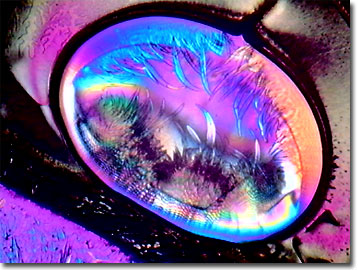Polarized Light Digital Image Gallery
Ascorbic Acid (Vitamin C)
Known in the over-the-counter food supplement trade as vitamin C, ascorbic acid, a water-soluble organic compound, is the most studied and debated of all the vitamins. Commonly found in nature in peppers, citrus fruits, tomatoes, melons, broccoli, and green leafy vegetables, vitamin C assists the body in the production of collagen, but is widely believed to be a strong antioxidant, a fighter of cancer, and a key player in detoxifying the body of foreign substances.

View a second image of crystallized ascorbic acid.
Because it is water-soluble, ascorbic acid must be replenished on a regular basis and is concentrated in the watery portions of fruits and vegetables. As one of the least chemically stable molecules in the vitamin family, this weak acid is easily destroyed by mild alkali solutions such as baking soda. After ingestion, vitamin C is readily absorbed by the intestines and may be found in tissue water throughout the body.
Scurvy, a nutrient deficiency of vitamin C, was prevalent with sailors lacking fresh fruit and vegetables in their diets on long voyages, and its symptoms were described in the Ebers Papyrus, one of the oldest known medical texts of ancient Egypt. In 1747, Scottish Naval surgeon James Lind discovered that citrus fruits could cure scurvy and soon thereafter, the Royal Navy included such fruits as oranges, lemons, and limes in the diet of sailors. The famous voyages of Captain James Cook were made possible by Lind's discovery and the nickname for British soldiers, particularly sailors, as "Limeys" has stuck ever since.
In its natural state, ascorbic acid appears as a white or yellow crystal or powder. The chemical name, ascorbic acid, actually refers to the levorotary isomer, L-ascorbic acid. Originally known just as the "anti-scurvy vitamine", vitamin C was isolated in natural foods in 1928 by Hungarian biochemist and Nobel Prize recipient Albert Szent-Gyorgyi. The biochemical was first synthesized independently by Nobel Prize winners Sir Walter Norman Haworth in England and Tadeus Reichstein in Switzerland in 1933. The all-time champion of vitamin C, double Nobel Laureate Linus Pauling, published his breakthrough book Vitamin C, the Common Cold and the Flu in 1970. Unlike humans, some primates, and guinea pigs, most mammals retain a metabolic process for manufacturing their own ascorbic acid. Although, all scientists agree that humans need vitamin C in their diet and for its role in forming collagen, the jury remains out on its reported near-superpowers for fighting viruses, the common cold, and a wide variety of cancers.
Contributing Authors
Omar Alvarado, Thomas J. Fellers and Michael W. Davidson - National High Magnetic Field Laboratory, 1800 East Paul Dirac Dr., The Florida State University, Tallahassee, Florida, 32310.
BACK TO THE POLARIZED LIGHT IMAGE GALLERY
BACK TO THE DIGITAL IMAGE GALLERIES
Questions or comments? Send us an email.
© 1995-2025 by Michael W. Davidson and The Florida State University. All Rights Reserved. No images, graphics, software, scripts, or applets may be reproduced or used in any manner without permission from the copyright holders. Use of this website means you agree to all of the Legal Terms and Conditions set forth by the owners.
This website is maintained by our
Graphics & Web Programming Team
in collaboration with Optical Microscopy at the
National High Magnetic Field Laboratory.
Last Modification Friday, Nov 13, 2015 at 01:19 PM
Access Count Since September 17, 2002: 8350
Visit the website of our partner in introductory microscopy education:
|
|
